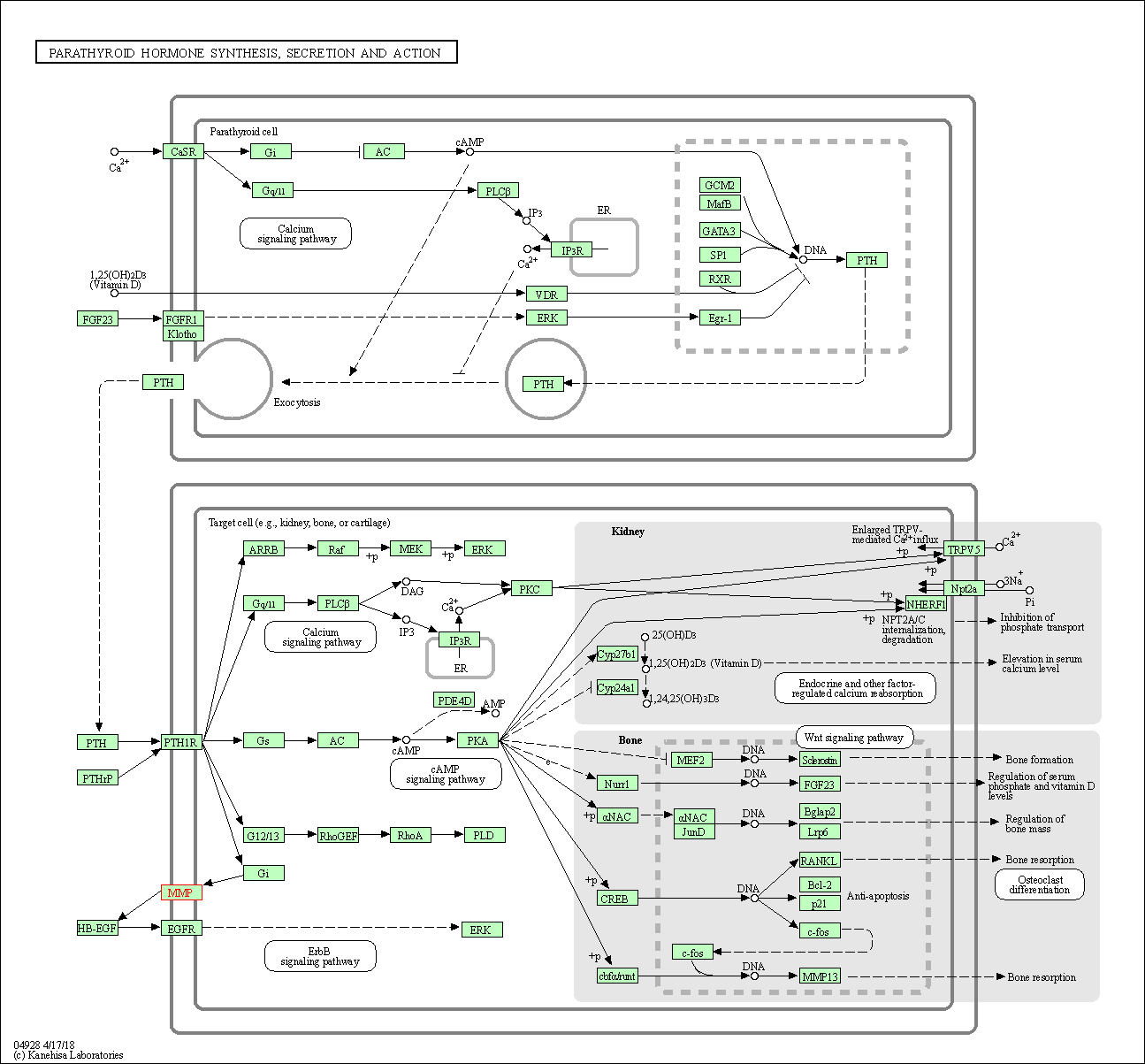Target Information
| Target General Information | Top | |||||
|---|---|---|---|---|---|---|
| Target ID |
T35824
(Former ID: TTDI03390)
|
|||||
| Target Name |
Matrix metalloproteinase-16 (MMP-16)
|
|||||
| Synonyms |
Membrane-type-3 matrix metalloproteinase; Membrane-type matrix metalloproteinase 3; MTMMP3; MT3MMP; MT3-MMP; MT-MMP 3; MMPX2; MMP-X2; C8orf57
Click to Show/Hide
|
|||||
| Gene Name |
MMP16
|
|||||
| Target Type |
Literature-reported target
|
[1] | ||||
| Function |
Activates progelatinase A. Involved in the matrix remodeling of blood vessels. Isoform short cleaves fibronectin and also collagen type III, but at lower rate. It has no effect on type I, II, IV and V collagen. However, upon interaction with CSPG4, it may be involved in degradation and invasion of type I collagen by melanoma cells. Endopeptidase that degrades various components of the extracellular matrix, such as collagen type III and fibronectin.
Click to Show/Hide
|
|||||
| BioChemical Class |
Peptidase
|
|||||
| UniProt ID | ||||||
| EC Number |
EC 3.4.24.-
|
|||||
| Sequence |
MILLTFSTGRRLDFVHHSGVFFLQTLLWILCATVCGTEQYFNVEVWLQKYGYLPPTDPRM
SVLRSAETMQSALAAMQQFYGINMTGKVDRNTIDWMKKPRCGVPDQTRGSSKFHIRRKRY ALTGQKWQHKHITYSIKNVTPKVGDPETRKAIRRAFDVWQNVTPLTFEEVPYSELENGKR DVDITIIFASGFHGDSSPFDGEGGFLAHAYFPGPGIGGDTHFDSDEPWTLGNPNHDGNDL FLVAVHELGHALGLEHSNDPTAIMAPFYQYMETDNFKLPNDDLQGIQKIYGPPDKIPPPT RPLPTVPPHRSIPPADPRKNDRPKPPRPPTGRPSYPGAKPNICDGNFNTLAILRREMFVF KDQWFWRVRNNRVMDGYPMQITYFWRGLPPSIDAVYENSDGNFVFFKGNKYWVFKDTTLQ PGYPHDLITLGSGIPPHGIDSAIWWEDVGKTYFFKGDRYWRYSEEMKTMDPGYPKPITVW KGIPESPQGAFVHKENGFTYFYKGKEYWKFNNQILKVEPGYPRSILKDFMGCDGPTDRVK EGHSPPDDVDIVIKLDNTASTVKAIAIVIPCILALCLLVLVYTVFQFKRKGTPRHILYCK RSMQEWV Click to Show/Hide
|
|||||
| 3D Structure | Click to Show 3D Structure of This Target | AlphaFold | ||||
| Cell-based Target Expression Variations | Top | |||||
|---|---|---|---|---|---|---|
| Cell-based Target Expression Variations | ||||||
| Drug Binding Sites of Target | Top | |||||
|---|---|---|---|---|---|---|
| Ligand Name: Batimastat | Ligand Info | |||||
| Structure Description | Crystal structure of the catalytic domain of MMP-16/MT3-MMP: Characterization of MT-MMP specific features | PDB:1RM8 | ||||
| Method | X-ray diffraction | Resolution | 1.80 Å | Mutation | No | [2] |
| PDB Sequence |
GQKWQHKHIT
133 YSIKNVTPKV143 GDPETRKAIR153 RAFDVWQNVT163 PLTFEEVPYS173 ELENGKRDVD 183 ITIIFASGFH193 GDSSPFDGEG203 GFLAHAYFPG213 PGIGGDTHFD223 SDEPWTLGNP 233 NHDGNDLFLV243 AVHELGHALG253 LEHSNDPTAI263 MAPFYQYMET273 DNFKLPNDDL 283 QGIQKIYGP
|
|||||
|
|
||||||
| Click to View More Binding Site Information of This Target with Different Ligands | ||||||
| Different Human System Profiles of Target | Top |
|---|---|
|
Human Similarity Proteins
of target is determined by comparing the sequence similarity of all human proteins with the target based on BLAST. The similarity proteins for a target are defined as the proteins with E-value < 0.005 and outside the protein families of the target.
A target that has fewer human similarity proteins outside its family is commonly regarded to possess a greater capacity to avoid undesired interactions and thus increase the possibility of finding successful drugs
(Brief Bioinform, 21: 649-662, 2020).
Human Pathway Affiliation
of target is determined by the life-essential pathways provided on KEGG database. The target-affiliated pathways were defined based on the following two criteria (a) the pathways of the studied target should be life-essential for both healthy individuals and patients, and (b) the studied target should occupy an upstream position in the pathways and therefore had the ability to regulate biological function.
Targets involved in a fewer pathways have greater likelihood to be successfully developed, while those associated with more human pathways increase the chance of undesirable interferences with other human processes
(Pharmacol Rev, 58: 259-279, 2006).
Biological Network Descriptors
of target is determined based on a human protein-protein interactions (PPI) network consisting of 9,309 proteins and 52,713 PPIs, which were with a high confidence score of ≥ 0.95 collected from STRING database.
The network properties of targets based on protein-protein interactions (PPIs) have been widely adopted for the assessment of target’s druggability. Proteins with high node degree tend to have a high impact on network function through multiple interactions, while proteins with high betweenness centrality are regarded to be central for communication in interaction networks and regulate the flow of signaling information
(Front Pharmacol, 9, 1245, 2018;
Curr Opin Struct Biol. 44:134-142, 2017).
Human Similarity Proteins
Human Pathway Affiliation
Biological Network Descriptors
|
|
|
There is no similarity protein (E value < 0.005) for this target
|

| KEGG Pathway | Pathway ID | Affiliated Target | Pathway Map |
|---|---|---|---|
| Parathyroid hormone synthesis, secretion and action | hsa04928 | Affiliated Target |

|
| Class: Organismal Systems => Endocrine system | Pathway Hierarchy | ||
| Degree | 2 | Degree centrality | 2.15E-04 | Betweenness centrality | 2.02E-04 |
|---|---|---|---|---|---|
| Closeness centrality | 1.64E-01 | Radiality | 1.25E+01 | Clustering coefficient | 0.00E+00 |
| Neighborhood connectivity | 4.50E+00 | Topological coefficient | 5.00E-01 | Eccentricity | 14 |
| Download | Click to Download the Full PPI Network of This Target | ||||
| Chemical Structure based Activity Landscape of Target | Top |
|---|---|
| Target Poor or Non Binders | Top | |||||
|---|---|---|---|---|---|---|
| Target Poor or Non Binders | ||||||
| Target Regulators | Top | |||||
|---|---|---|---|---|---|---|
| Target-regulating microRNAs | ||||||
| References | Top | |||||
|---|---|---|---|---|---|---|
| REF 1 | Design, synthesis, and structure-activity relationships of macrocyclic hydroxamic acids that inhibit tumor necrosis factor alpha release in vitro and in vivo. J Med Chem. 2001 Aug 2;44(16):2636-60. | |||||
| REF 2 | Crystal structure of the catalytic domain of MMP-16/MT3-MMP: characterization of MT-MMP specific features. J Mol Biol. 2004 Feb 6;336(1):213-25. | |||||
If You Find Any Error in Data or Bug in Web Service, Please Kindly Report It to Dr. Zhou and Dr. Zhang.

